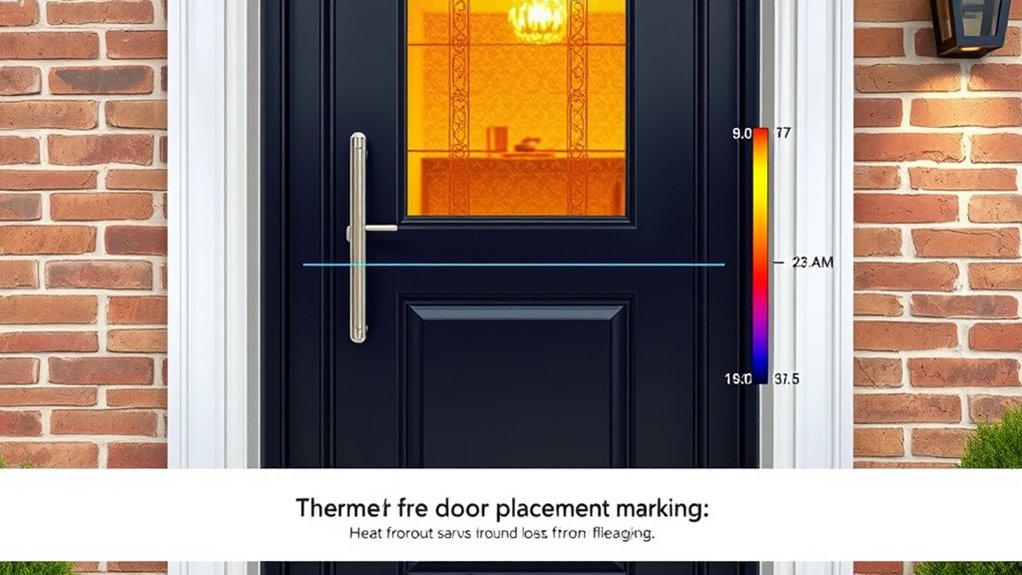A door placement and heat loss calculator helps you understand how your door position affects energy efficiency and comfort. It considers factors like door size, materials, and outdoor temperatures to estimate how much heat you lose through gaps, insulation, and leaks. Proper placement away from wind and sun reduces drafts, while sealing and insulating doors minimizes heat escape. Keep exploring to discover how smarter door placement and upgrades can make your home cozier and more efficient.
Key Takeaways
- Proper door placement reduces drafts and heat loss by minimizing gaps where warm air escapes and cold air enters.
- The heat loss calculator estimates energy loss through doors based on size, material, placement, and outdoor temperature.
- Accurate measurements and input of door details help identify areas where insulation and sealing improvements are needed.
- Strategic door positioning away from wind and sun minimizes unwanted heat transfer, improving home comfort and efficiency.
- Upgrading door insulation and sealing gaps can significantly decrease heat loss, saving energy and reducing heating costs.
Why Door Placement Matters for Home Comfort
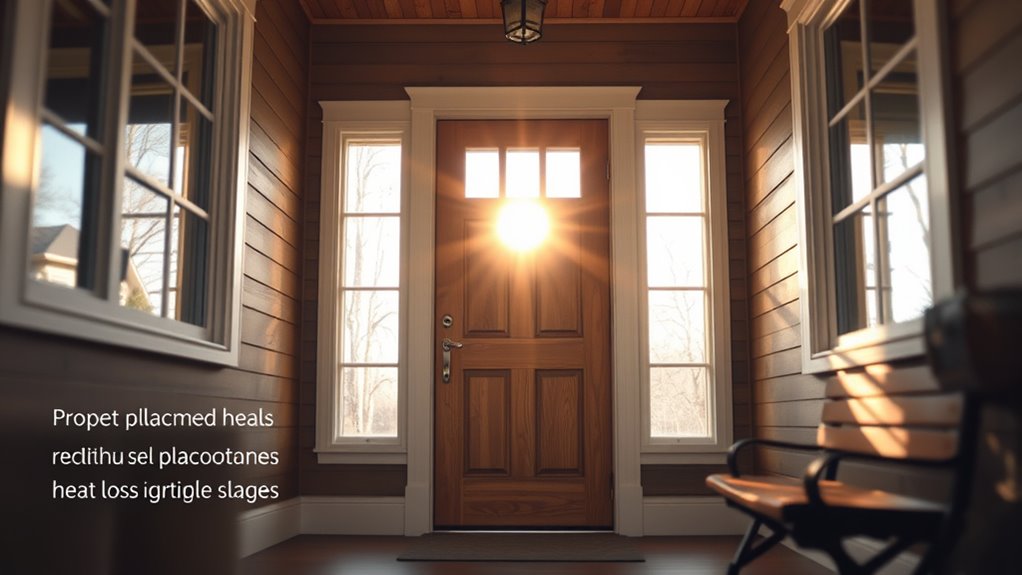
The placement of your doors considerably impacts your home’s overall comfort because it affects how heat flows between rooms and to the outside. Properly positioned doors help maintain consistent indoor temperatures and reduce energy costs. When considering door aesthetics, choose locations that enhance your home’s style while ensuring functional flow. Security considerations are equally important; placing doors in strategic spots can improve safety and prevent unauthorized access. Avoid awkward door placements that create drafts or hinder movement. Well-placed doors can also minimize heat loss by preventing drafts and cold air infiltration. Think about how each door’s position influences both visual appeal and safety, ensuring your home stays warm, secure, and inviting. Effective door placement balances aesthetics, security, and energy efficiency seamlessly. Additionally, understanding how heat loss occurs can help you make more informed decisions about door placement to maximize energy savings.
How Heat Loss Happens Through Doors
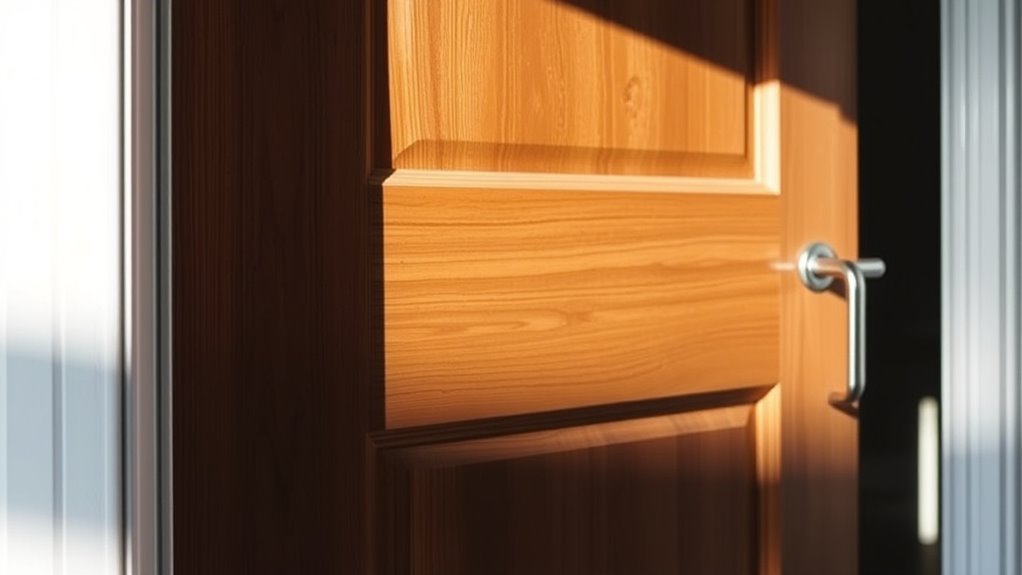
Door placement not only influences airflow and aesthetics but also directly affects how heat escapes your home. When doors aren’t properly positioned, they can create pathways for heat to escape through thermal bridging, where heat transfers across the door frame or the surrounding wall. Additionally, gaps around doors lead to air leakage, allowing warm indoor air to escape and cold air to enter. This exchange reduces your home’s energy efficiency and increases heating costs. Poorly placed doors or those without proper sealing can substantially boost heat loss, especially during winter. Understanding these factors helps you minimize heat escape through strategic door placement, sealing gaps, and choosing energy-efficient doors. Proper planning ensures your home stays warmer longer, saving you money and improving comfort. Moreover, employing advanced detection techniques can help identify hidden leaks and thermal bridges that contribute to heat loss.
Components of a Door Placement and Heat Loss Calculator
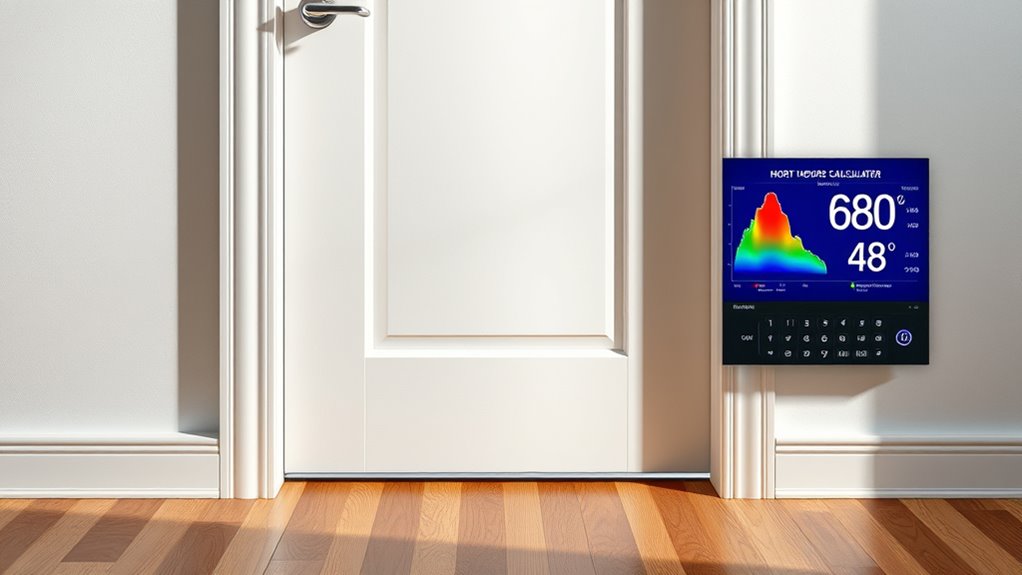
A door placement and heat loss calculator relies on several key components to accurately assess how much heat escapes your home. First, it considers the door’s thermal insulation properties, which determine how well it prevents heat transfer. Second, it factors in the building’s overall energy efficiency, affecting heat retention. Third, it uses precise measurements of door size and location to evaluate potential heat loss pathways. Additional elements include:
- Material properties, such as R-value, influencing insulation effectiveness
- External climate data, like outdoor temperature and wind conditions
- Indoor temperature settings to gauge differential heat flow
- Inverter generator technology details, which can impact energy efficiency in backup power scenarios
These components work together to provide a detailed understanding of how door placement impacts your home’s energy efficiency and help identify strategies to reduce heat loss effectively.
Step-by-Step: How to Use the Calculator

To get accurate results, start by measuring your door dimensions precisely. Next, input your data correctly into the calculator to guarantee everything is accurate. Additionally, understanding whether your door is airtight or not can help you interpret the results more effectively. Finally, read the results carefully to understand your door’s impact on heat loss and make informed decisions.
Measure Door Dimensions Precisely
When measuring door dimensions for accurate heat loss calculations, precision is key. You need exact measurements of height and width to ensure the calculator provides reliable results. Use a sturdy tape measure, and double-check each dimension for consistency. Keep in mind that door materials and weather conditions can influence heat transfer, so precise measurements help account for these factors. To improve accuracy:
- Measure at multiple points to catch irregularities in door frame
- Record measurements in inches or centimeters, depending on the calculator’s preference
- Note the door’s location and surrounding environment for context
- Understanding the impact of insulation properties can further refine your heat loss estimates
Accurate measurements help you better understand how door size affects heat loss, especially under varying weather conditions and different door materials. This step guarantees your calculations are as precise as possible.
Input Data Correctly
Ensuring you input data correctly is essential for accurate heat loss calculations. First, select the door aesthetics that match your style, as this influences options like finish and design. Next, carefully input the door’s dimensions, such as width and height, to guarantee precise calculations. When choosing material selection, consider insulation properties, as different materials impact heat loss differently. Double-check your entries for accuracy, since incorrect data can lead to misleading results. Be consistent with units—use inches or centimeters throughout. Accurate measurements and thoughtful choices about door aesthetics and material selection help you get reliable estimates. Taking your time during input ensures the calculator provides meaningful insights into how your door affects your home’s heat efficiency. Additionally, understanding the room layout and how the door placement impacts airflow can further improve the accuracy of your heat loss assessment.
Read Results Carefully
After you’ve entered all your data accurately, it’s important to interpret the results carefully. Look beyond the numbers to understand what they mean for your door placement and heat loss. Pay attention to how the results might influence door aesthetics, ensuring the door complements your interior design without sacrificing efficiency. Consider the heat loss calculation when choosing door installation techniques—proper sealing and insulation can profoundly reduce energy loss. Additionally, understanding the signs of increased heat loss can help you identify potential issues with your current door setup.
- Review the recommended door placement to balance aesthetics and heat retention
- Check if the heat loss amount aligns with your comfort goals
- Use the results to adjust your door installation techniques for maximum efficiency
Interpreting the Results and What They Mean

Once you see the results, it’s important to understand what the numbers reveal about your door placement. Recognizing how heat loss impacts your space helps you identify areas for improvement. With this knowledge, you can make smarter decisions to enhance energy efficiency and comfort. Being aware of best small wood stoves options can also help you find alternative heating solutions that complement your insulation efforts.
Understanding the Numbers
When reviewing your heat loss calculations, it’s important to understand what the numbers really mean for your home’s energy efficiency. They reveal how much heat escapes through your door, highlighting areas where door insulation can be improved or draft prevention measures are needed. Clear interpretation helps you prioritize upgrades effectively. For example, using insulation techniques can significantly reduce heat loss and improve overall comfort.
Recognizing Heat Loss Impact
Interpreting your heat loss results helps you understand how your door’s performance affects your home’s energy efficiency. If the calculator shows high heat loss, it indicates your door isn’t providing adequate thermal efficiency, leading to increased energy bills and comfort issues. Recognizing this impact helps you see where insulation strategies can make a difference. For example, a poorly insulated door allows more heat to escape, reducing overall thermal efficiency. By understanding these results, you can identify areas where upgrading insulation or choosing better door materials will substantially improve your home’s energy performance. Keep in mind that even small improvements in insulation can lead to better heat retention and lower heating costs, making your home more comfortable and energy-efficient. Additionally, understanding the principles of heat transfer can help you select more effective insulation solutions for your door and surrounding areas.
Making Informed Decisions
Understanding your heat loss calculator results is essential for making informed decisions about improving your home’s energy efficiency. These results reveal where heat escapes and help you prioritize upgrades. When interpreting the data, consider factors like color options—darker doors absorb more heat, which can affect warmth retention—and door hardware, as poorly sealed hardware increases heat loss. To optimize your choices, keep in mind:
- Selecting doors with better insulation properties based on the heat loss data
- Choosing color options that enhance energy efficiency without sacrificing style
- Upgrading door hardware to improve sealing and reduce drafts
Tips for Reducing Heat Loss Around Doors
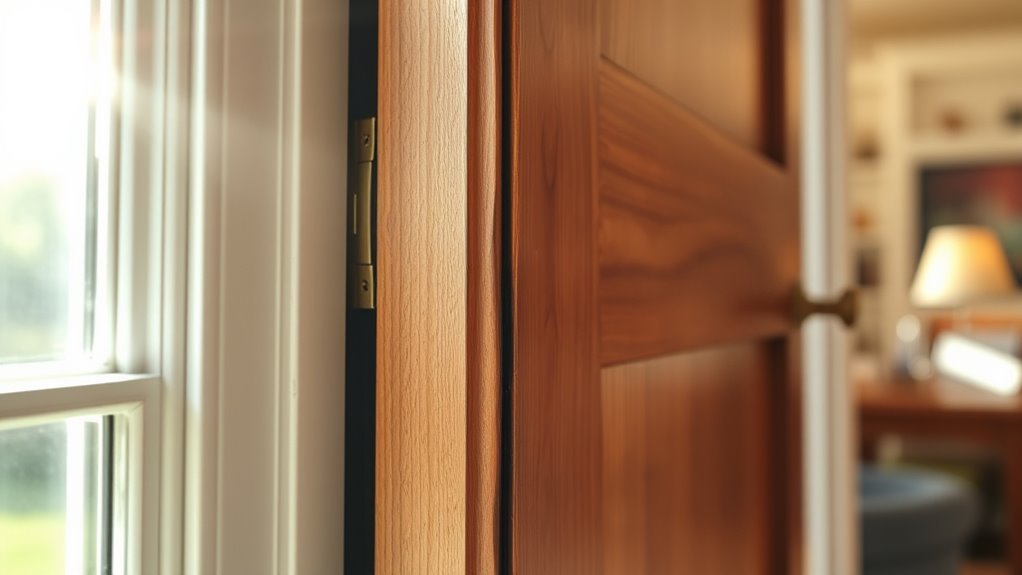
To effectively reduce heat loss around your doors, start by sealing gaps and cracks with weatherstripping or door sweeps. Proper weather sealing prevents drafts and keeps warm air inside. Consider insulation upgrades, such as adding foam or insulated panels around the door frame, to further improve energy efficiency. These upgrades help slow heat transfer and maintain a comfortable indoor temperature. Make sure your door fits snugly in its frame, minimizing gaps that let heat escape. Regularly inspect and replace weatherstripping to maintain an effective seal. Combining weather sealing with insulation upgrades creates a stronger barrier against heat loss, reducing your heating bills and increasing comfort. Taking these steps ensures your doors contribute less to overall energy waste in your home.
Practical Examples of Improved Door Placement Strategies
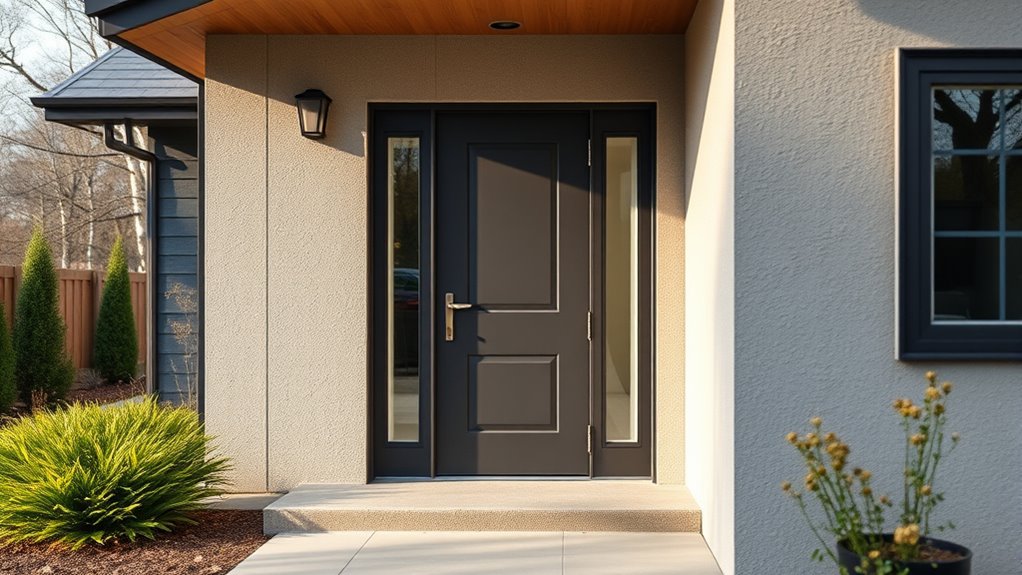
Strategically positioning doors can substantially reduce heat loss and improve your home’s energy efficiency. For example, placing the exterior door on the side shielded from prevailing winds minimizes drafts and heat escape. Choosing the right door material, such as insulated steel or fiberglass, adds an extra layer of thermal protection. Additionally, incorporating security features like reinforced frames and multi-point locking enhances safety without sacrificing efficiency.
Consider these practical strategies:
- Position doors away from direct sunlight to prevent heat gain in summer
- Use weatherstripping and thresholds for tighter seals around door frames
- Opt for doors with high thermal resistance and integrated security features
Applying these tactics ensures your doors contribute to a warmer, safer, and more energy-efficient home.
Frequently Asked Questions
Can Door Placement Affect Energy Bills Significantly?
Yes, door placement can notably impact your energy bills. Properly positioned doors minimize drafts and heat loss, leading to better energy savings. Placing doors away from windows or shaded areas helps maintain indoor temperature and reduces heating or cooling demands. By paying attention to door placement, you can improve your home’s energy efficiency and lower monthly utility costs, making your home more comfortable and cost-effective in the long run.
What Materials Best Insulate Doors for Heat Retention?
Oh, because everyone dreams of a door that doubles as a heat vault, right? The best door materials for insulation are foam-filled steel, fiberglass, and wood. They trap air effectively, boosting insulation effectiveness. These materials prevent heat from sneaking out and cold air from sneaking in. So, if you want your house to stay cozy and your bills to stay reasonable, pick doors with these insulating champions.
How Often Should I Recheck My Heat Loss Calculations?
You should recheck your heat loss calculations at least once a year, especially before seasonal changes. This allows you to account for seasonal adjustments and identify if insulation upgrades are needed. Regular checks help you stay on top of any shifts in your home’s efficiency, ensuring your door insulation remains effective. Consider re-evaluating after any major renovations or weather pattern changes to keep your heating costs ideal.
Are There Specific Door Types More Energy-Efficient?
Imagine replacing an old wooden door with a well-insulated fiberglass one. Fiberglass and steel doors, especially those with foam cores, are more energy-efficient than traditional wooden styles. These door materials reduce heat transfer, keeping your home warmer in winter and cooler in summer. Choosing energy-efficient door styles with proper insulation and weatherstripping can markedly cut heat loss, saving you money and improving comfort year-round.
How Do Weather Conditions Impact Door Heat Loss?
Weather conditions substantially impact door heat loss by increasing thermal bridging and air infiltration. Cold, windy weather causes more heat to escape through gaps and poorly insulated frames, raising your energy bills. Snow and rain can also weaken seals, allowing cold air inside. To minimize this, choose well-insulated doors, seal gaps properly, and consider weatherstripping. Staying proactive helps reduce heat loss and keeps your home warmer in harsh conditions.
Conclusion
By mastering door placement and using this calculator, you’ll turn your home into an impenetrable fortress against heat loss. Imagine sealing every icy draft, stopping the cold in its tracks, and transforming your living space into a cozy sanctuary so warm that winter’s chill feels like a distant memory. With these tips, you’ll be unstoppable—your home will stay toasty, saving you money and making you feel like you’ve built a fortress of warmth against the harshest winter storms.
